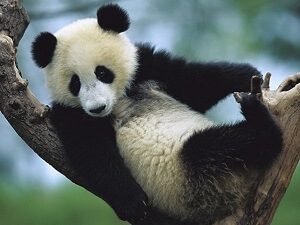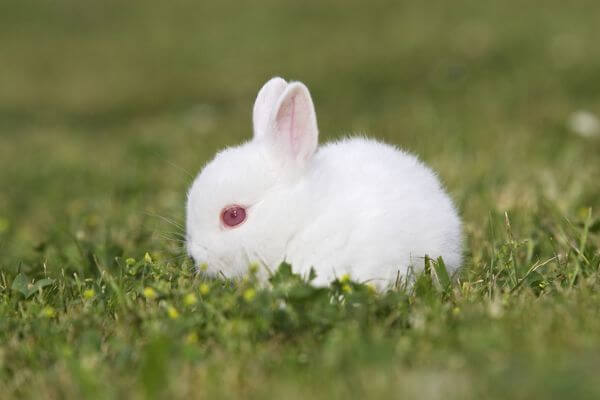There are only two different species of panda in the world, the giant panda and the red panda. Despite their common name, the two are not scientifically linked to each other. They live roughly in the same geographical area and have a similar diet. Both are also decreasing in terms of their population numbers.
The giant panda is actually a species of bear and is known around the world as the “panda bear”. These animals can be quite large and have a very distinct color. They are mainly white, with large black spots around the eyes, ears, and other parts of the body.
As the name “red panda” suggests, these creatures tend to get a more rusty color and are considerably smaller. In most cases, they resemble domestic cats both in size and agility and tend to live on more rocky, mountainous terrain. The two rarely, if ever, come in contact with each other in the wild.
Similarities between the giant panda and the red panda
Both animals are native to Central Asia, but their distribution areas tend to be slightly different. Researchers believe bears exist only in a few isolated bamboo forests in central-southern China.
Red pandas also live in this part of China, but their habitat also branches westward through Bangladesh, Bhutan, and Nepal. The name “panda” is believed to come from the Nepalese word “ponya”, which means “bamboo” – and indeed, bamboo is the main source of food for both creatures. This is a way of explaining the common name. In most other respects, animals are very different.
A feature that the red panda shares with the giant panda is a modified bone of the wrist of the front paw, which acts like a thumb, helping them catch the bamboo when they feed.
Facts about the giant panda
The giant panda is scientifically known as Ailuropoda melanoleuca, and molecular studies have shown that it is a real bear and belongs to the Ursidae family. It is widely regarded as one of the mildest bears and is predominantly an herbivore, which may explain its general lack of aggressiveness.
The average height of a giant panda is usually between five and six feet tall, 152.5-183 cm, about the height of an average human. However, they tend to weigh much more, with male bears regularly weighing more than 200 pounds, about 91 kg. Panda bears are a truly important part of Chinese culture and it is believed that it once was the most cherished animal from the emperor’s exotic animal garden.
You might also like my articles on red pandas, armadillos, and name ideas for polar bears.
Pandas will typically consume nearly 80 pounds, 36.4 kg of bamboo each day, which puts some limitation on their habitat. In other words, they need to live where forests are rich and dense and where there is always a constant supply of bamboo. It is also known to eat small rodents and other animals when food is scarce. They also tend to eat honey, eggs, fish, and fruits, such as oranges and bananas when they are available.
Animals will usually spend about 16 hours a day just eating. This type of panda has a paw consisting of a thumb and four fingers, and the only essential duty of the thumb is to hold the bamboo while eating. Animals are also climbers and, despite their weight and size, can often reach great heights. Thumbs can also help with this, at least when it comes to grabbing and pulling.
The differences between the red panda and the giant panda
For many years, scientists have wondered if the red panda itself is a species of bear, a raccoon, or something else, especially since it looks pretty much like a raccoon. But a lot of genetic studies have made it clear that they are not a species of bear.
The red panda, Ailurus fulgens, is a cat-sized relative of raccoons and ferrets. Although it was believed to be a relative of the panda bear, especially since it has this name, molecular analysis has found that it is not part of the bear family.
By comparison, the distant relative of the giant panda, the red panda, is only 50 to 65 cm tall and weighs 4,5 to 9 kg.
The red panda is one of the longest-tailed species, which could reach up to 5–6 cm long. These pandas live up to 25-30 years
Also called big bears, giant pandas are distinguished from the other type of pandas by their large size and black-and-white color. Their bold color provides camouflage, as it is almost invisible in dense bamboo areas.
The giant panda bears reach about 1.75 m in height. Males are 10-20% larger than females and weigh up to 150 kg, while females up to 125 kg.
Where do pandas live?
Giant pandas are native to China, where they were always considered a national treasure. Despite their status, giant pandas, Ailuropoda melanoleuca, are vulnerable as there are fewer than 1.900 in the wild. About 300 live in zoos around the world.
In the wild, the giant panda is found only in the remote, mountainous regions of central China, in the provinces of Sichuan, Shaanxi, and Gansu. In this area, at 1.524 – 3.048 m altitude, are the cool and humid bamboo forests that the giant panda loves. Large bears make their loungers out of hollowed logs or coniferous stumps found in the forest.
The red panda lives in the mountains of Nepal, central China, and northern Myanmar, in temperate rainforests, high altitudes, and tropical forests. An important factor in their habitat is bamboo. The forest must have a bamboo tree for it to be viable for the red panda.
What does the panda eat?
 Pandas consume exclusively bamboo leaves and sprouts. Bamboo is a high-growing sweet plant that the panda easily shreds. The panda’s teeth, which were initially suitable for ripping and shredding meat, later evolved by flattening, becoming specialized in grinding, to bring food to a paste consistency.
Pandas consume exclusively bamboo leaves and sprouts. Bamboo is a high-growing sweet plant that the panda easily shreds. The panda’s teeth, which were initially suitable for ripping and shredding meat, later evolved by flattening, becoming specialized in grinding, to bring food to a paste consistency.
The bamboo appetite of a giant panda is insatiable. They eat bamboo 12 hours a day, which is up to 28 pounds of bamboo every day. Panda bears have a special bone that extends from the wrists, called the “pseudo-thumb.” They use their pseudo-thumb to hold and manipulate the bamboo.
Bamboo is relatively low in nutrients, which is why the panda must eat so much. To get a variety of nutrients, the panda eats different parts of the bamboo plant and will look for new sprouts and leaves of bamboo that contain higher amounts of nutrients, including calcium, phosphorus, and nitrogen, at different times of the year. During the summer, the giant pandas will climb up to 3.900 m up the mountains in their native area to feed themselves.
Sometimes there is not enough bamboo around to support large bears, so giant pandas will occasionally supplement their diet with rodents, fish, insects, or birds.
The diet of a red panda consists of 85 to 95% bamboo. The red panda also eats bamboo sprouts and leaf tips. They can also look for roots, herbs, and fallen fruits. Sometimes they will eat eggs, insects, birds, and small mammals, but mostly they stick to the bamboo.
Although it is a large part of their diet, red pandas can only digest about 24% of the bamboo they eat. They need to consume 20% to 30% percent of their body weight, or about 1 to 2 pounds of sprouts and bamboo leaves per day. One study found that red panda females eat about 20.000 bamboo leaves in a single day.
Threats to the pandas’ habitat
Populations of both species of pandas are considered threatened but to varying degrees.
Giant pandas are widely classified as “endangered” and their population in the wild is estimated to be less than 1,600. Many zoos and nature reservations have spent enormous amounts of time and money trying to help the species grow, with the intention of increasing populations that roam freely in China, but the problem is a very complicated one. Habitat loss is the major problem in the decreasing number of giant panda bears.
Red bears are classified by wild animal groups as “vulnerable”, and their population is estimated at about 10,000 in the wild. The main threats to their survival are human development and land use, as well as traps. The red panda is often caught in devices entirely intended for other animals. In some cases, they are also hunted for their fur, which is sometimes wanted for clothing and accessories.




